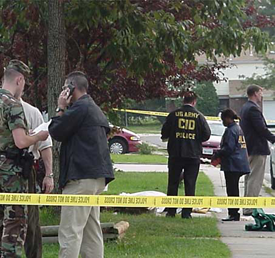Crime Scene Photography
The premise that a picture is worth a thousand words makes a photograph more compelling evidence than a written report or a testimony. Whatever reasons you may have for taking an interest in crime scene photography, or becoming a law enforcement photographer, you must know what the job entails before you go clicking your way to this career path.
Crime Scene Photographer Job Description

In a nutshell, a crime photographer is in charge of generating visual records of crime and accident scenes. The visual records or photographs can be used as evidence in court. Aside from taking pictures of material evidence, part of the forensic photographer’s job is to take pictures of injured civilians in the crime or accident scene. You also need to take still (both black and white) photos of prisoners, using a 4×5 camera and a 35mm camera. You may also be called as an expert witness in court to present the photographing evidence.
A crime scene photographer can be tasked to process forensic images in the dark room, using fixer baths, mixes developer, etc. You can also be responsible for filing and tracking forensic images in your department. You are required, depending on the department’s budget, to acquire specific cameras and lenses as needed. You are expected to handle equipment such as contact printers and enlargers, and stock supplies such as the materials in a photo documentation kit. Some mundane duties of a crime scene photographer include taking identification photographs of the employees in the law enforcement agency and becoming the official photographer in public relation events of the agency.
A forensic photographer description varies from one law enforcement agency to another. In small counties, you might be tasked to perform all responsibilities related to evidence photography. In bigger government offices, law enforcement photographers are classified according to specialization:
Forensic Photographer Specializations
- A Lab Technician processes the film’s development, produces photo enlargements, and record and file of all photographs and negatives used by the department.
- A Crime Scene Specialist or CSS is in charge of crime scene photography, including taking photos of evidence such as bodies at the scene of the crime and at autopsies.
- A Forensic Photographer has more expertise in crime photography, and is only called when particularly complex photography (such as Luminol or ultraviolet photography) is required. Luminol is used by crime scene investigators to find small traces of blood, even if the area has been cleaned.
Additional Specializations
- Accident Reconstruction
- Aerial
- Ballistics
- Biological & Medical
- Crime Scene
- Forensic Lab
- Fire Investigation Injuries
- Infrared & UV
- Latent Prints
- Microphotography
- Micro Picture
- Physical Evidence
- Photomacrography & Photomicrography
- Photogrammetry
- Industrial & Product Liability
- Questioned Documents
- Radiography
- Surveillance
- Time Lapse
- High Speed
- Underwater
- Videography
Forensic & Evidence Photographer Organizations
Evidence Photographers International Council, Inc.
229 Peachtree St. NE, #2200
Atlanta, GA 30303
Phone: 866-868-EPIC (3742)
Fax: 404-614-640
Professional Photographic Certification Commission
(part of EPIC)
229 Peachtree Street NE Suite 2200
Atlanta, GA 30303
Phone: 888-772-2780
http://www.certifiedphotographer.com/cep-certification/current-certified-evidence-photographers



